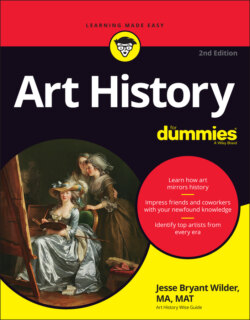Читать книгу Art History For Dummies - Jesse Bryant Wilder - Страница 115
Akhenaten and Egyptian family values
ОглавлениеThe 18th-dynasty pharaoh Amenhotep IV (1352 BC–1355 BC) launched a new monotheistic religion in Egypt, built around the sun god Aten (a variation of the sun god Re). Amenhotep IV shut down the temples of competing gods, especially Amun, whose powerful priests tried to prevent the new religion from taking root.
The pharaoh changed his name from Amenhotep, which means “Amun is satisfied,” to Akhenaten, meaning “It pleases Aten.” Then he moved the capital from Thebes, where the cult of Amun was strongest, to a new location that he dubbed Akhetaten. (The modern name of the city is Amarna.) The artists and architects who Akhenaten hired to announce his new religion created a new style of art, which art historians call the Amarna style (Akhenaten style or Akhenatenism is too hard to say, even for an art historian).
Akhenaten ordered that open-air temples be built to celebrate the light and love of the sun god in a more natural setting. Honesty was of central importance in the new religion, so artists had to depict people, including the pharaoh, more honestly — in other words, in everyday situations with all their flaws. The statue of Akhenaten in the Egyptian Museum in Cairo, for example, reveals his pot belly!
One of the best examples of the Amarna style is the family portrait of Akhenaten, his queen Nefertiti, and their three young daughters (see Figure 6-3).
D.serra1 / Shutterstock
FIGURE 6-3: Akhenaten’s family portrait brings the royal family down to earth while linking them to the god Aten.
This family portrait suggests that belief in one god seems to have encouraged more humanity, including
A close family: The youngest princess, who is still an infant, plays with her mother’s earring. Akhenaten tousles the hair of the princess in his arms while she points to the ankh (symbol of life) at the tip of a sun ray. The other princess holds Nefertiti’s hand and points toward her father, which helps to interlink the family. Depicting intimacy between parents and children was new in Egyptian art.
A balanced relationship: The sun disk (representing Aten) in the relief spreads its rays equally on the king and queen, suggesting that they are co-rulers governing a balanced kingdom under one god.
This portrait of Akhenaten’s family is a sunken relief. The artist incises the image into the stone rather than cutting out the background, as in raised relief.
The painted bust of Akhenaten’s queen Nefertiti, shown in Figure 6-4, is the most famous female bust in Egyptian art. Her magnificent jewelry (typical of the Amarna period, in which exquisite jewelry flourished) echoes the color pattern of the band in her headdress. The queen is both idealized (the epitome of grace and elegance) and realistic — note the realism in her high cheekbones, mouth, and chin. Her rounded shoulders and forward-leaning neck highlight her perfection and humanity. Her name means “the beauty that has come.”
